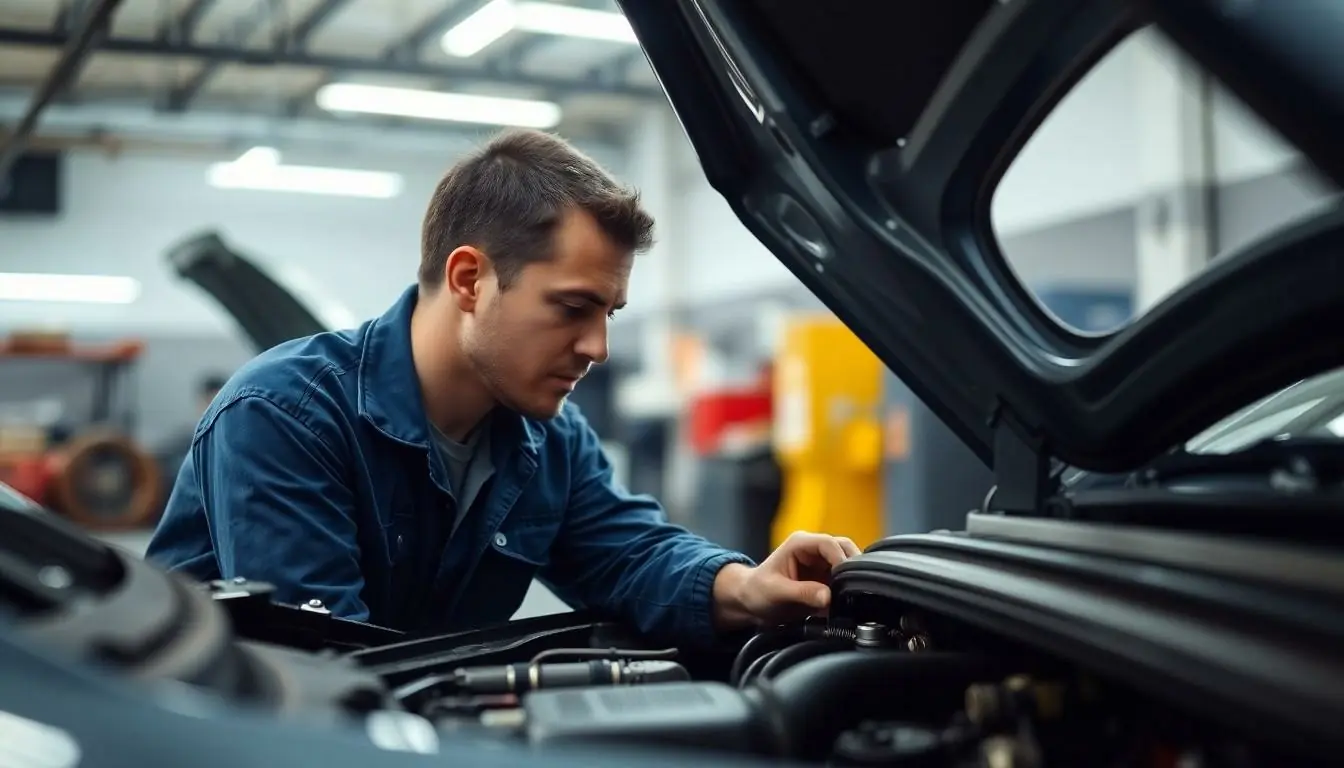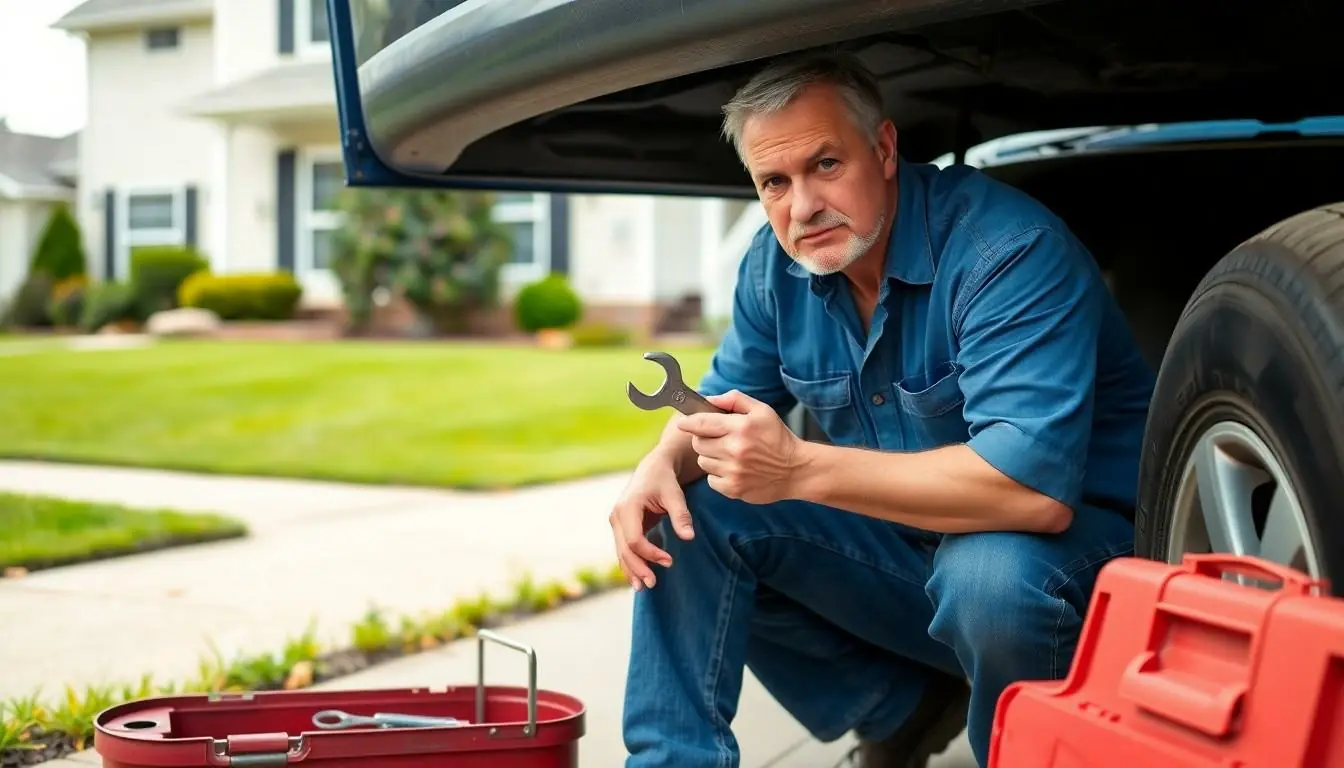Every car owner knows the sinking feeling that comes when the check engine light flickers to life. It’s like a bad surprise party—uninvited and potentially expensive. But fear not! Maintenance and light repair don’t have to be a daunting chore. In fact, with the right tips and tricks, it can be as simple as changing a light bulb (and far less dangerous than juggling chainsaws).
Table of Contents
ToggleOverview of Maintenance and Light Repair
Maintenance encompasses routine tasks aimed at keeping a vehicle in optimal condition. Regular checks can prevent unexpected breakdowns. Simple procedures like oil changes, tire rotations, and brake inspections play crucial roles in preserving vehicle performance.
Light repair involves minor fixes that address wear and tear. Replacing windshield wipers, fixing headlights, or repairing scratches can enhance safety and aesthetics. It’s essential to tackle these tasks promptly to avoid escalating issues.
Certain tools facilitate maintenance and light repair. Basic tools include wrenches, screwdrivers, and pliers. Utilizing these tools empowers car owners to undertake straightforward repairs, saving both time and money.
Knowing when to seek professional help is equally important. If a problem persists or is beyond basic repairs, consulting a mechanic may prove necessary. They possess specialized knowledge to diagnose complex issues accurately.
Maintaining a vehicle doesn’t require extensive expertise. Following a routine schedule reinforces vehicle longevity. Online guides and videos provide accessible instructions for various tasks, encouraging car owners to become more hands-on.
It remains vital to keep records of maintenance and repairs. Documenting services performed aids in tracking performance and helps maintain resale value. Comprehensive records reflect responsible ownership and can assist in future transactions.
Taking these proactive measures can minimize potential repair costs. Car owners equipped with maintenance knowledge often find managing their vehicle less daunting. Prioritizing these tasks ensures a safer, more reliable driving experience.
Importance of Maintenance and Light Repair

Car maintenance and light repair play crucial roles in ensuring vehicle health and performance. Regular upkeep leads to several key benefits that car owners should recognize.
Benefits for Vehicle Longevity
Routine tasks, such as oil changes and tire rotations, extend a vehicle’s lifespan significantly. These tasks maintain engine efficiency and improve overall operation. Addressing minor issues, like a worn-out wiper blade, prevents further complications. Regular inspections spot potential problems early, allowing for timely fixes. Vehicles that receive consistent care demonstrate increased reliability and reduced risk of sudden breakdowns.
Cost-Effectiveness in the Long Run
Investing in maintenance saves money over time. Regular service lowers the chances of expensive repairs caused by neglect. For instance, an oil change often costs less than replacing an engine. Performing minor repairs, like fixing a small dent, prevents further damage that can escalate costs. Studies show that well-maintained vehicles retain higher resale values. Car owners experience peace of mind knowing they’ve minimized expenses related to unexpected repairs.
Common Maintenance Tasks
Routine vehicle maintenance tasks enhance longevity and performance. Car owners often overlook these essential services.
Oil Changes
Oil changes rank among the most critical maintenance tasks. Typically, it’s recommended to replace engine oil every 3,000 to 7,500 miles, depending on vehicle type. Fresh oil ensures smooth engine operation and enhances efficiency. Neglecting this task can lead to engine wear and decreased fuel economy. Scheduling regular oil changes keeps the engine lubricated and functioning optimally, which is vital for long-term vehicle health.
Tire Rotations
Tire rotations promote even tire wear and extend tire life. Experts advise rotating tires every 5,000 to 8,000 miles. During this process, the position of the tires shifts, maintaining balanced handling and traction. Even tire wear contributes to safer driving conditions and reduces the risk of blowouts. Regular rotations also improve fuel efficiency, as tires in proper condition enhance a vehicle’s overall performance.
Brake Inspections
Brake inspections ensure vehicle safety and performance. A professional typically checks brake pads, rotors, and fluid levels every 20,000 to 30,000 miles. Routine assessments prevent costly repairs caused by worn components. Drivers should also monitor signs of brake issues, such as squeaking or inefficient stopping. Addressing brake problems promptly maintains vehicle safety and reliability, creating a safer driving experience overall.
Light Repair Techniques
Light repair tasks empower car owners to manage minor issues effectively. Addressing these can enhance vehicle performance and safety.
Electrical System Troubleshooting
Electrical problems often manifest as dim lights or malfunctioning accessories. Begin by checking the battery connections, ensuring they’re tight and clean. After that, inspect fuses; a blown fuse may impede power delivery. Additionally, using a multimeter can help test voltage and identify faulty components. Resolving these issues promptly maintains functionality and avoids more significant problems down the line.
Minor Bodywork Repairs
Minor bodywork repairs can significantly enhance a vehicle’s appearance. Dents and scratches can often be remedied with DIY methods. Use a hairdryer or heat gun to warm the affected area, then apply a suction cup to pull out small dents. For scratches, touch-up paint in the correct color can restore the finish. Investing time in these repairs not only improves aesthetics but also protects against rust and further damage.
Tools and Equipment Needed
Having the right tools and equipment simplifies vehicle maintenance and light repair tasks. These essential items enable car owners to perform basic procedures effectively.
Essential Tools for DIY Maintenance
Wrenches and sockets serve as fundamental tools for loosening and tightening bolts and nuts. A selection of screwdrivers, including flathead and Phillips-head, facilitates various tasks like replacing battery terminals. Pliers assist in gripping and bending components as needed. Tire gauges ensure proper tire pressure, which enhances vehicle safety and performance. Oil change kits contain all necessary elements such as oil filters and drain pans to streamline oil changes. Overall, assembling a basic toolbox fosters independence for car owners when managing routine maintenance tasks.
Safety Equipment
Safety glasses protect eyes from debris and fluids while working on a vehicle. Gloves provide grip and prevent injuries from sharp parts. A jack and jack stands lift the vehicle safely during underbody repairs. Fire extinguishers offer a safeguard against potential fires caused by flammable liquids or electrical issues. First aid kits prepare for minor injuries that may occur during repair work. Prioritizing safety equipment ensures that car owners can perform maintenance tasks confidently and securely.
Maintaining and repairing a vehicle doesn’t have to be daunting. By embracing routine maintenance and light repairs, car owners can significantly enhance their vehicle’s longevity and performance. Simple tasks like oil changes and tire rotations not only prevent major issues but also save money in the long run.
Equipped with the right tools and knowledge, individuals can tackle minor repairs themselves, improving safety and aesthetics. Staying proactive with maintenance schedules and keeping detailed service records can lead to a more reliable driving experience. Ultimately, taking these steps fosters confidence and peace of mind, ensuring that every journey is as smooth as possible.





